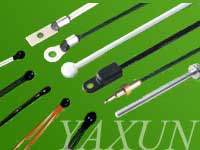PTC and NTC basic difference

PTC and NTC are Thermistor.
According to the temperature coefficient is divided into positive temperature coefficient Thermistor (PTC) and negative temperature coefficient Thermistor (NTC). Positive temperature coefficient Thermistor (PTC) in the higher the temperature the greater the resistance value. Negative temperature coefficient Thermistor (NTC) in the higher the temperature the lower the resistance value. They belong to the same semiconductor device.
First, PTC Thermistor:
1. PTC Thermistor Application: Electronic ballasts for a variety of fluorescent lamps, electronic energy-saving lamps, Do not have to change the line. The appropriate Thermistor directly connected across the resonant capacitor in the lamp at both ends. You can change the electronic ballast, electronic energy-saving lamps for the warm-start. So that filament preheat time of 0.4 to 2 seconds to extend lamp life more than three times.
2. PTC Thermistor features: PTC Thermistor is a typical temperature-sensitive semiconductor resistors, When the temperature exceeds a certain temperature (Curie temperature), Its resistance value increases step by step with the increase of temperature.
3. PTC Thermistor working principle:
PTC is a semiconductor heating ceramics, When the outside temperature decreases, The resistance value of the PTC decreases, Calorific value but will be a corresponding increase. Said material has PTC (Positive Temperature Coefficient) effect, Namely positive temperature coefficient effect, Only the resistance of this material will increase with increasing temperature. Such as most metal materials have a PTC effect. Of these materials, The PTC effect shows that the resistance increases linearly with increasing temperature, This is known as the linear PTC effect.
4. PTC Thermistor material composition:
PTC (Positive Temperature CoeffiCient ) refers to a sharp increase in resistance at a temperature, A Thermistor phenomenon or material having a positive temperature coefficient, Can be used as a constant temperature sensor. The material is a sintered body containing BaTiO3 or SrTiO3 or PbTiO3 as a main component. In which a small amount of Nb, Ta, Bi, Sb, Y, La and other oxides for atomic control and semi- Often such semiconductor materials such as BaTiO3 semi-conductive (body) porcelain; At the same time, adding Mn, Fe, Cu, Cr and other additives which increase the positive temperature coefficient of resistance. Using the general process of ceramic molding, high temperature sintering so that the platinum titanate and its solid solution semiconducting, Thereby obtaining a Thermistor material having a positive characteristic. The temperature coefficient and Curie temperature with the composition and sintering conditions (especially the cooling temperature) vary.
5. PTC Thermistor use of different categories:
Automatic degaussing PTC resistance, Delay start with a PTC resistor, Constant temperature heating PTC resistor, PTC protection for overcurrent protection, PTC Thermistor for overtemperature protection, Sensor with PTC resistors,
Second, NTC Thermistor:
1. NTC Thermistor features:
Negative temperature coefficient Thermistor, also known as NTC Thermistor, Is a type of resistance value decreases with increasing temperature of a sensor resistance. Widely used in a variety of electronic originals, Such as temperature sensors, Can be double-fuse and automatically adjust the heater, and so on.
2. PTC Thermistor Application:
Electronic thermometer, Electronic calendar, Electronic clock temperature display, Electronic gifts;Heating and cooling equipment, Heating thermostat;Automotive electronic temperature measurement and control circuit;Temperature Sensor, Temperature instrumentation;Medical electronic equipment, Electronic washing equipment;Mobile phone batteries and charging appliances.
3. NTC Thermistor working principle:
When the temperature is low, the oxide material has a small number of carriers (electrons and holes), So its resistance value is higher;With the increase of temperature, The number of carriers is increased, so that the resistance value is lowered. NTC Thermistor at room temperature in the range of 10O ~ 1000000 ohms, Temperature coefficient -2% ~ -6. 5%. NTC Thermistor is widely used in temperature measurement, temperature control, temperature compensation and so on.
4. NTC Thermistor material composition:
NTC (Negative Temperature CoeffiCient) refers to the exponential relationship with the temperature rise resistance decreases, Thermistor phenomena and materials with negative temperature coefficient. The material is a kind of semi-conductive ceramics made by using two or more kinds of metal oxides such as manganese, copper, silicon, cobalt, iron, nickel and zinc to fully mix, shape and sinter. Can be made with a negative temperature coefficient (NTC) of the Thermistor. The resistivity and material constants vary with the material composition ratio, sintering atmosphere, sintering temperature and structure state. Non-oxide NTC Thermistor materials such as silicon carbide, tin selenide, tantalum nitride and the like have also been developed. NTC thermally conductive porcelain is mostly spinel structure or other structure of oxide ceramics, With a negative temperature coefficient, the resistance value can be approximated as:
Rt = RT * EXP (Bn * (1 / T-1 / T0)
Where RT, RT0, respectively, temperature T, T0 when the resistance value, Bn for the material constant.
The resistivity of the ceramic grains itself changes due to the temperature change,
This is determined by the characteristics of the semiconductor.
5. NTC Thermistor Uses classification:
Temperature, temperature control, temperature compensation, power type Thermistor.
Third, the power-type Thermistor Product Features:
In order to avoid the electronic circuit in the boot of the moment the surge current, In the power supply circuit in series with a power NTC Thermistor. Can effectively curb the surge current when the boot, And after the suppression of the inrush current effect is completed, As a result of the ongoing action of its current, The resistance value of the power type NTC Thermistor will drop to a very small degree. It consumes power can be ignored, Will not affect the normal operating current, Therefore, the use of power in the power loop NTC Thermistor, Is to suppress the boot when the surge, To protect electronic equipment from damage the most simple and effective measures.





